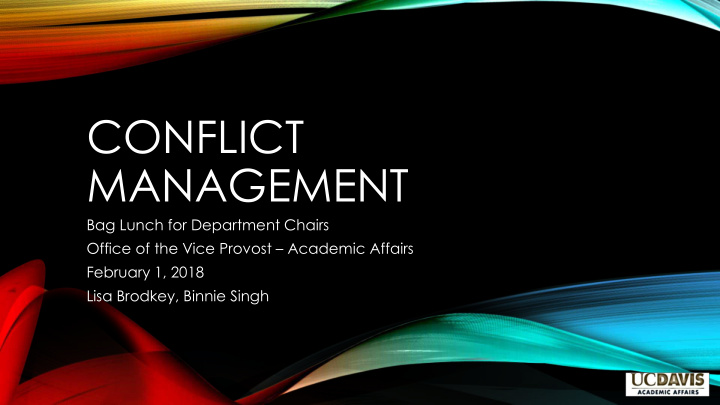



CONFLICT MANAGEMENT Bag Lunch for Department Chairs Office of the Vice Provost – Academic Affairs February 1, 2018 Lisa Brodkey, Binnie Singh
BROWN BAG OBJECTIVES • Provide strategies to address issues and minimize potential for escalation • Increase awareness of ripple effect of conflict • Review resources for department chairs in managing conflict • Identify gaps in support for chairs – what issues aren’t being addressed adequately?
OVERVIEW/AGENDA • Conflict management in academia • Proactive steps to take • Steps to conflict management • Case studies • The aftermath of conflict • Resources • What’s missing
UNIQUE FACTORS IN ACADEMIA THAT IMPACT CONFLICT MANAGEMENT • Faculty autonomy & • Rotational nature of independence leadership • Team-oriented • Differing philosophies decision-making on • Competition for department limited resources issues/changes within the College or • Pre-tenure vs. post- discipline tenure dynamics • Other factors? • Lengthy faculty careers Source: Mending the Cracks in the Ivory Tower: Strategies for Conflict Management in Higher Education by Cynthia Berryman-Fink
SCENARIO • You’ve noticed that two members of your department seem to be at odds. You used to see them chatting in each other’s offices, often going out for coffee/lunch, and joking together at meetings. You realize that lately, you haven’t seen any of that happening. In fact, they seem to be going out of their way not to sit near each other in department meetings. • What issues, if any, come up for you? • What, if anything, will you do or say?
BE PROACTIVE • “Living the Principles of Community” eCourse (and facilitated discussion, speakers, etc.) • Use faculty meetings to set climate and allow for input & feedback • Foster discussions regarding how, as a department and interpersonally, issues are addressed • Follow through and follow up consistently • Model effective behavior and engagement
STEPS TO MANAGING CONFLICT Plan Act Resources (consult) Document
Managing conflict is less HARD When you remember P.A.R.D. Plan Act Resources Document
PLAN: QUESTIONS TO ASK AND SHARE WITH RESOURCES • Potential policy violation? Required to notify anyone? • What harm is caused by this conflict? • What do I know about the parties? • Is there prior history? Who would know? • Who can help determine the best approach? • Logistics - when, where, and how to intervene?
ACT: THINGS TO CONSIDER • Intervene early and often! • Perfection is not the goal • You know the person, what approach will work • One example: “Documented conversations” with talking points from Academic Affairs • keep the conversation on track • develop consistency for future cases • use them to create the documentation of the conversation
PANEL EXPERIENCES Edward Dickinson, Chair, Department of History/L&S Marty Usrey, Chair, Department of Neurobiology, Physiology, and Behavior/CBS
RESOURCES: CONSULTING • Your Dean’s Office is a great place to start. • They may be familiar with the issue and have insights and strategies to address the problem. • Academic Affairs would be a good next office to consult about these types of issues. We may have more history about the parties involved and can offer ideas on approach.
RESOURCES: CONSULTING Reasons to consult with campus resources: Reduce potential for escalation • Responding and managing in a manner consistent with the level of issue • You don’t have to be the “expert” • Extra help • You may be too close to those involved (colleagues) – need outsider’s • view Large issues, policy implications • Share the liability • Note: AA works regularly and closely with a number of campus resources
WHEN MUST YOU CONSULT OR ELEVATE AN ISSUE?
RESOURCE LIST
SCENARIO • The tension seems to be increasing between your two faculty members. Yesterday, you overheard two graduate students discussing the friction between these two professors. Each of these students works with one of these professors, and they’ve all been collaborating on a project – until recently. The students are expressing frustration about how their work on the project is stalled since these two professors won’t talk to each other and have recently bad-mouthed each other in front of the students. • What issues, if any, come up for you? • What, if anything, will you do or say?
DOCUMENT: • Document for yourself along the way, as needed (note to file) • When appropriate, document back to the individual(s) • Don’t keep unnecessary documentation in your file • If this has happened before, documenting may not be enough – may need to elevate (dean, Academic Affairs, etc.)
THE AFTERMATH • Confidentiality - need to know • Ripple effect • Support services
TIPS FOR MINIMIZING HARM • Share what can be shared (consult about this with central campus) --- ambiguity breeds fear and catastrophizing • Over-communicate – People don’t hear well when they’re stressed • Accept and promote the idea that conflict is part of being human
LET’S ACKNOWLEDGE… • You can’t control other people’s actions, decisions, etc. • You’re close to those involved • Fight or flight – a body’s response to threat (reputational, emotional, not necessarily physical) • Anxiety is a response to emotion, not an emotion itself (A re you angry, sad, guilty, apprehensive …)
WHERE ARE THE GAPS?
THANK YOU!
Recommend
More recommend